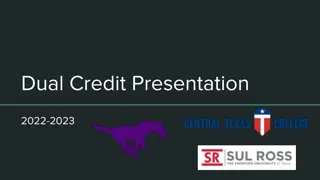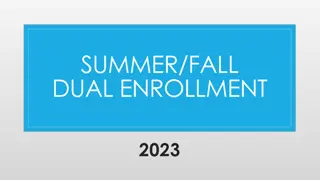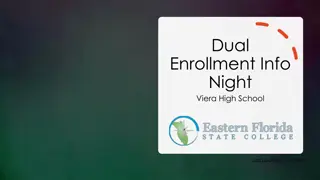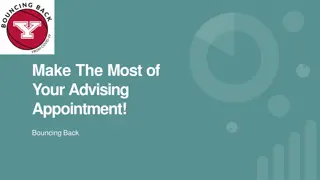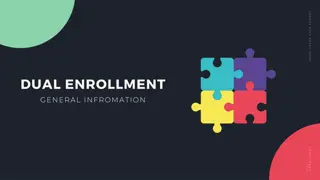Career Advising for Dual Enrollment Students: Making Dreams a Reality
This presentation explores the journey of dual enrollment students through programs like Running Start, highlighting the impact on career development. It delves into why students choose this path, the experience gained, and action plans for success. Collaborative efforts between universities and employers are emphasized to support these non-freshman freshmen. Surveys play a crucial role in gathering insights from participating students.
Download Presentation

Please find below an Image/Link to download the presentation.
The content on the website is provided AS IS for your information and personal use only. It may not be sold, licensed, or shared on other websites without obtaining consent from the author. Download presentation by click this link. If you encounter any issues during the download, it is possible that the publisher has removed the file from their server.
E N D
Presentation Transcript
Career Advising for the Non-Freshman Freshman: Helping Dual Enrollment/ Running Start Students Make Their Dream a Reality Cybrina Cooper - Alyssa Nastasi - Beverly Vari
Dual enrollment - concurrent enrollment Dual Enrollment/Concurrent Enrollment: program that allows students to be enrolled in two separate, academically related institutions 2 million students enrolled nationwide Individual state resource
What is Running Start? Washington, New Hampshire, Hawaii, Montana, and Illinois; a type of dual enrollment program Washington State: provides up to 2 years of paid tuition Washington Running Start participation follows national trend, continually increasing Expectations of the students
Traditional Student vs. Running Start Traditional student Graduate HS & enter UNI Graduate UNI HS YR1 HS YR2 HS YR3 HS YR4 UNI YR1 UNI YR2 UNI YR3 UNI YR4 Exploration Specialization Avg. age 22 Running Start Student Graduate HS Graduate UNI HS YR1 HS YR2 HS YR3 HS YR4 Avg. age 20 Skips RS/CC YR1 RS/CC YR2 UNI YR3 Exploration UNI YR4 Specialization Junior credit status, but technically a freshman. Non-Freshman Freshman
Poll Why do you think students participate in Running Start/take dual enrollment classes?
Outline What brought us here? Who are the students? Why did they take this route? How does this impact Career Development? Importance of gaining experience Activity Action plans
What brought us here? Career Development, Pre-College Outreach, Orientation = co-located at UW Tacoma Massive increase in RST students Public/private comparison and employer perspective prompted collaboration with SMU and Enterprise Identified we needed more data
Surveys, surveys everywhere University of Washington Tacoma Four-year urban-serving university, undergrad enrollment: 4550 This fall, surveyed 177 first year Running Start students via email Received 37 responses (20% response rate) Saint Martin s University Four-year undergraduate and graduate; private, Catholic, liberal arts university, undergrad enrollment: 1300 Surveys sent to all SMU students via email 60 responses, of those 53 were Running Start
Background on non-freshman freshman What motivated you to participate in Running Start? SMU UWT I wanted to save money 75.5% 83.8% I was ready for more challenging college classes I wanted to finish college faster/enter workforce sooner 69.8% 64.9% 62.3% 75.7% I didn t want to stay in high school 58.5% 75.7% Results from 2018 student survey
Background on non-freshman freshman Entering workforce under 21 with a bachelor's degree Anticipated age at the time of graduation SMU UWT 18-20 28% 73% 21-25 60% 27%
Background on non-freshman freshman While participating in Running Start, did you use Career Center/Career Advising? SMU UWT Was available, but didn t use 54.7% 56.7% Participated in 1-2 meetings or appointments 20.8% 29.7% Participated in 3-4 meetings or appointments 5.7% 0% Participated in more than 5 meetings or appointments 1.9% 5.4% Not available at my college 11.3% 8%
Emerging Question What could the Running Start/Dual Enrollment Career Development Model on your campus look like?
Campus impact Campus-wide Faculty and classroom Each campus is identifying ways to prepare students: examples UWT/SMU Emerging questions: How can we best prepare students post-grad? What are employers noticing?
Employer perspective - importance of gaining experience SMU surveyed employers (15 responses) Top 3 skills employers reported most important from recent college graduates* Ability to work in a team Strong work ethic Problem solving skills Top 3 skills employers reported lacking from recent college graduates Initiative Flexibility Communication skills (written)/Strong work ethic (tie) *All graduates, not just Running Start
Employer perspective - importance of gaining experience What you get by achieving your goals, is not as important as what you become by achieving your goals. - Zig Ziglar
Instructions for activity - student personas All personas are based on real experiences/students* Get in groups around a student persona Student A (employer scenario) Student B (career development scenario) Student C (employer or career development scenario) Read the description and discuss how you would support that student! *Key information is changed to protect student identity; some information combined from multiple students
Student A You are an employer that is sitting down with Khloe in an information interview. Khloe entered into the university with enough credits to make her a junior even though she s technically a first-year student. She is eager to land a job as a manager at a large retail operation. She s excited to graduate next year and start her career at just 19 years old. She has a 3.7 GPA and keeps busy with her studies. Help Khloe land her first big career move!
Student B Emmett is a 20 year old senior who joined Running Start in the first place because his girlfriend was participating. They broke up and he still remained in the program but without a friend/support base. He didn t explore, get an internship, or use his resources to the max while completing Running Start courses, nor in college. He stayed focused on school and just wanted to finish. As a soon to be graduate, he thought his last hope was attending a networking event to try to find a job. He registered for the event, showed up, but wasn t allowed in because there was alcohol present and he was not 21 as a senior. What would you recommend that he do?
Student C Hailey is a 21 year old senior in Civil Engineering who joined Running Start because she wanted to save money on student loans and finish school faster to enter into the workforce. During her last 2 years at the university, she has not had the time to get involved with any on- campus leadership organizations or jobs related to her field (she works as a barista to help pay for her expenses). She s nervous she won t get hired because of her lack of experience, so she shows up to the Spring STEM Fair. What advice do you give her?
How can we support these students? The best way to predict the future .is to create it! Articulate what they have done in the classroom if they do not have other experience - Husky Experience, UW Seattle Elevator pitch Network! Share what employers want with the students -Abraham Lincoln
Questions to consider How is dual enrollment impacting the needs of students at your organization? What opportunities does this changing population open up for your work? How can you help educate and lead within your organization to support this population of students? (early adopters, professional opp)
Thank you Beverly Vari, Career Development Specialist University of Washington Tacoma Bvari@uw.edu Cybrina Cooper, Talent Acquisition Specialist Enterprise Holdings Cybrina.R.Cooper@ehi.com Alyssa Nastasi, Assistant Director and Internship Coordinator Saint Martin s University Anastasi@stmartin.edu






